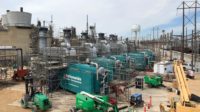Over the past few decades, the modernization and retrofitting of older, large, urban buildings have brought about the need to install building energy management systems (BEMS) that aim to assist building managers in paving the way for smarter energy usage and that provide occupants in those buildings maximum comfort.
It’s no secret that large, urban buildings play an increasingly impactful role in energy consumption, which is why they’re a focal point when it comes to future smart grid efforts.
In a recent article, researchers present a method for detecting faulty HVAC terminal units (TU) remotely and automatically, all using a big data framework to construct and process the large volume of data. Further, the study suggests using a novel feature extraction method that’s encouraged by proportional integral derivative (PID) controllers.
How exactly does this research suggest using big data and PIDs to detect faulty units?
This article discusses new research, the science behind it, and the conclusions researchers draw with respect to how using big data and PID controllers can revolutionize BEMS, energy efficiency, and maximum occupant comfort.
How Can Big Data and PID Controllers Automatically Detect Faulty HVAC TUs?
The aforementioned research paper reports on an experiment that took place in central London with data collected from TU fan coil units (called FCU). According to the study, a single TU consists of various data streams including:
- Control temperature, which is measured by each TU;
- Set point temperature, which is the desired or target control temperature of the unit;
- Deadband, which is the control temperature band or the range within the process that creates two separate outputs of heating and cooling set points;
- Heating and cooling valve or damper actuator control and feedback signals; and
- Enabled signal to indicate the hours of operation.
Even though such TUs are considered simple devices, they can face a number of issues that cause faulty behaviors, such as:
- Poor control;
- Varying set points;
- Out of hour operation;
- Poor sensor location;
- Localized effects;
- Unachievable set points;
- TU’s inability to receive adequate flow or upstream temperatures;
- Competition with nearby TUs; and
- Incorrect TU sizing for the actual demand.
To fully understand and diagnose these issues, researchers deduced that a data-based investigation that would weave supervised and unsupervised learning into the mix would be integral. Data investigations provide ideal conditions for active learning, hands-on experience, and multifaceted problem-solving, but for researchers, it was clear that manual TU data investigation was going to be incredibly tedious.
Bringing intelligence to the process, using data mining, and machine learning seemed to be the ideal solution.
For this purpose, they conducted an experiment that looked at a 17th-floor building in central London with 731 TUs distributed across different floors. Researchers used six different set parameters for this experiment. Based on these parameters, the demand and control strategies were varied and dealt with real-time TU issues.
Raw data was collected on these TUs, comprising information like timestamps, voltage, temperature, and more. Because this experiment was conducted in a real environment, typical problems arose, such as different sampling rates for different attributes, missing values for timestamps, etc.
For this purpose, the TUs with missing data were filtered and linearly interpolated to resample the data.
Researchers collected the BEMS data by using a single embedded PC connected to the BEMS network as a network node, which is then connected to the internet. That PC is embedded with software that is used to obtain a map of the BEMS network, poll the values of the data points (typically in intervals of 30 minutes), store and buffer the data if the internet connection is lost, and securely send the data to the cloud servers.
After aggregating, collecting, and cleaning the data, a few unique experiments were conducted on four types of data volume, including daily, weekly, monthly, and randomly selected data from July to October. Raw data was transformed for each TU.
The different TU data was analyzed and the characteristics for functioning and malfunctioning were grouped into patterns. Researchers used clustering to deduce the possible partitions of the data by varying cluster patterns. The TUs were then labeled using the clustering outcomes, and classifications were performed.
The Results: Can This Research Provide a Solution for Technical Changes Within Existing Infrastructure?
Based on the parameters of the experiments in this study (and based on the fact that real TU behavior is analyzed remotely in this work), a story is formed around the HVAC and its direct environment. For example, real data can be provided on the building under test, and this can enable managers to investigate only the faulty HVAC units.
From these results, it can be deduced that faulty behavior can be both automatically and remotely identified and classified — in other words, using this new information, an investigator can remotely identify whether an HVAC issue is being caused by the environment or by the specific HVAC unit itself. Further, predictive fault finding can be achieved using the classifications the results presented — this is important because it can be used to ensure timely interventions. Prompt responses are useful in cases where fault is assumed, because this information can help pinpoint the particular issues a TU is showing, even if the TU itself isn’t “broken” (just faulty).
This study suggests that a novel feature extraction technique could extract temperature and power associated features from high dimensional and unstructured TU data — ultimately, this provided a good approximation for the TU characteristics. The study also suggests that these methods could be used to predict faults on more recent data by using the semi-supervised learning techniques, but, ultimately, more information and further tests are needed to thoroughly explore faults like set point temperatures and improper dead bands.
With this information and the ability to automate the detection of faulty HVAC units, new techniques can be used to make technical changes within the existing infrastructure to cut back on energy consumption and convert what would traditionally be manual labor to AI processes.





